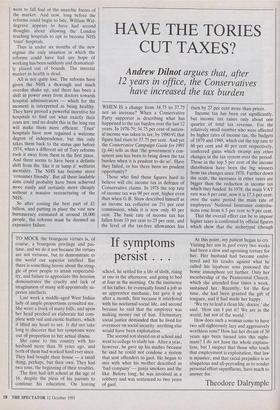HAVE THE TORIES CUT TAXES?
Andrew Dilnot argues that, after
12 years in office, the Conservatives have increased the tax burden
WHEN IS a change from 34.75 to 37.75 not an increase? When a Conservative Party supporter is describing what has happened to the tax burden over the last 12 years. In 1978-79; 34.75 per cent of nation- al income was taken in tax; by 1990-91 that figure had risen to 37.75 per cent. And yet the Conservative Campaign Guide for 1991 (p.44) tells us that 'the government's con- sistent aim has been to bring down the tax burden when it is prudent to do so'. Have they failed, or has there been no prudent opportunity?
Those who find these figures hard to believe will cite income tax in defence of Conservative claims. In 1978 the top rate of income tax was 98 per cent, higher even than when G.B. Shaw described himself as an income tax collector on 21/2 per cent commission, while it is now only 40 per cent. The basic rate of income tax has fallen from 33 per cent to 25 per cent, and the level of the tax-free allowances has risen by 27 per cent more than prices.
Income tax has been cut significantly, but income tax raises only about one quarter of total tax revenue. For the relatively small number who were affected by higher rates of income tax, the budgets of 1979 and 1988, which cut the top rate to 60 per cent and 40 per cent respectively, conferred gains which swamp any other changes in the tax system over the period. Those in the top 5 per cent of the income distribution have been the big winners from tax changes since 1978. Further down the scale, the increases in other taxes are bigger than the reduction in income tax which they funded. In 1978, the main VAT rate was 8 per cent, now it is 17.5 per cent; over the same period the main rate of employees' National Insurance contribu- tions rose from 6.5 per cent to 9 per cent.
That the overall effect can be to impose higher taxes is confirmed by official figures which show that the archetypal (thougl rather rare) family, a married man on average earnings with a wife without paid work and two children, paid a larger share of its income in tax in 1990-91 than in 1978-79, even ignoring local taxes.
Turning back to the Campaign Guide (p.46), we find some clarification. 'Of course, what really matters for most indi- viduals and families is not the burden, or the balance, of the tax system, but their real take-home levels of pay and the living standards these bring them.'
This may seem like a specious argument, but there is a point here in the Govern- ment's favour. One of the main reasons that someone on average earnings in 1990- 91 is paying more in tax than in 1978-79 is that average earnings have risen much more quickly than prices, and the tax system takes a larger share of higher incomes. If we abstract from changes in earnings, and simply adjust the whole 1978-79 tax system for inflation since then, and apply it to someone on average earn- ings now, it would produce a higher tax bill than the current system. Despite the higher share of tax, the real standard of living of our archetypal family is higher now than in 1978-79.
But there are groups for which even this is not true. The main characteristic of the big losers is that they were not paying income tax in the first place, so could not gain from the cuts in income tax, while losing from the increases in VAT which helped to pay for the income tax cuts. The unemployed, the retired, and the sick are those most likely to fall into this category.
There is no avoiding the conclusion that in commonsense terms the tax burden has. risen. The significant reductions in income tax have been offset by increases in other personal taxes such as VAT and National Insurance contributions, and by some in- creases in the burden of taxes on com- panies. But even company taxes end up being paid by individuals as shareholders, employees, or consumers.
There remains something of a paradox here. The Conservative Government was elected in 1979 on the expectation that it would cut the share of public spending in National Income, and do the same for taxation. Public spending has fallen, from 44 per cent of National Income to 40.5 per cent by 1990-91, reversing a long-standing trend which was widely believed to be unstoppable. Why hasn't taxation followed expenditure"? The simple answer is that the Government's greatest success has been in cutting borrowing, not taxation. In 1978-79 Public Sector Borrowing was some 5.5 per cent of National Income; by 1990-91 it was minus 0.25 per cent, having been as low as minus 3 per cent in 1988-89. As the economy grew through the 1980s, public spending was allowed to grow a little faster than prices, but not as fast as tax revenues, which grew even faster than the economy. Although some of the 'spare' tax revenue was given back in the form of tax cuts, much of it went to reduce borrowing, and in the second half of the 1980s actually to pay off the National Debt. This has per- manently reduced the level of interest payments which must be met from public spending, effectively making a gift to fu- ture taxpayers. Cutting borrowing, and therefore taxes in the future, rather than cutting taxes in the present may look like a virtue. But will it be rewarded at the polls?
Andrew Dilnot is Director of the Institute for Fiscal Studies.



























































 Previous page
Previous page